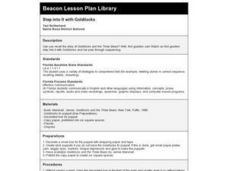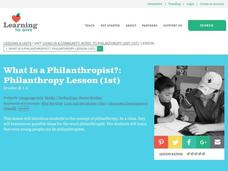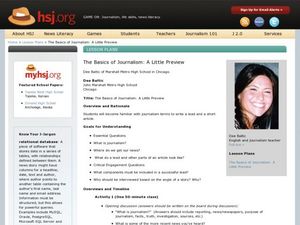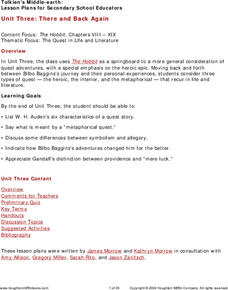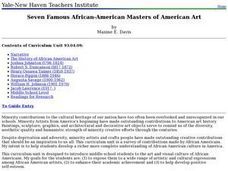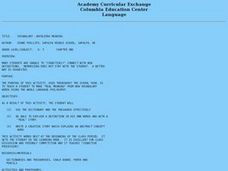Curated OER
STEP INTO IT WITH GOLDILOCKS
First graders use sequencing to recall and tell the story of Goldilocks and the Three Bears. They create a storyboard using pencils first and then crayons with six illustrations in sequence.
Curated OER
When the Fly Flew In
Explore visual and verbal recall and sequencing with your youngsters. Start by reading a story and completing a worksheet after listening to the story. They work to identify the main idea and supporting details. The worksheet is included...
Curated OER
Writing a News Article
For this writing worksheet, pupils learn the essentials about how to write a newspaper article in journalistic style. Students read about style, headlines, bylines, first, middle and ending paragraphs. After reading this, pupils will be...
Curated OER
Zoom! Zoom! Zoom! I'm Off to the Moon Sequencing Lesson
Students practice sequencing. In this sequencing lesson, students listen to the book Zoom! Zoom! Zoom! I'm Off to the Moon. They put the story events in sequential order using a graphic organizer.
Curated OER
My Owl Babies Miss Momma
Students investigate the relationship between children and parents by reading a book about owls. In this story analysis lesson plan, students read the book Owl Babies and participate in a role play based on one of the characters....
Curated OER
Awesome Authors
Students are introduced to authors and discover they are real people. Using the author's stories, they are incouraged to write their own stories using technology. Using the internet, they research facts, ideas and stories and develop a...
Curated OER
What is a Philanthropist?
Students discuss the conceptual framework of philanthropy. In this introduction to philanthropy lesson, students define the term philanthropist and read the story Lion and the Mouse. Students discuss the concepts of philanthropy...
Curated OER
All Kinds of Books
Pupils engage in a variety of book making activities to foster creativity, literacy, and fine-motor skills. In this book-making lesson plan, students author a book about the days of the week, illustrating the activities that they...
Curated OER
Writing Lesson Plan: Stop and Go: Capitals and Periods
Examine writing using a fun, interactive format. Young writers choose a piece of their own writing to proofread for initial capitals and final periods they left out. They work independently using green stickers to add capitals and red...
Curated OER
The Basics of Journalism: A Little Preview
Students define journalism and identify the basic components of a news story. In this journalism basics lesson, students define the word journalism, read a new story, and break it into parts with two major characteristics for each...
Curated OER
Storytelling in the Oral Tradition
Seventh graders research Greek mythological characters. They write about problems faced by middle school-aged children and how the character would handle them. Students also create story boards to accompany their oral narratives.
Curated OER
The Woman Who Slept for Thirty Years
Students are given a bit of information, but must share their information with other students in order to learn enough to solve the puzzle. When students have all the clues, they construct a theory to explain the facts. The teacher adds...
Curated OER
American Born Chinese
Students make thematic connections and organize their ideas using a Venn Diagram. In this Venn Diagram instructional activity, students compare 3 different stories from a novel and fill in a Venn Diagram. Students then discuss their...
Curated OER
the Little Red Riding Hood
Young scholars respond to the story of Little Red Riding Hood. In this Red Riding Hood instructional activity, students retell and discuss story elements. Young scholars practice phonic sounds. Students role play, make...
Curated OER
The Hobbit
Students list W.H Auden's six characteristics of a quest story. They say what is meant by a "metaphorical quest." Pupils discuss some differences between symbolism and allegory. Students indicate how Bilbo Baggins's adventures changed...
Curated OER
Shelling a Pecan
In this pecans worksheet, 3rd graders fill out a graphing organizer sequencing how someone shells a pecan. Students also draw someone shelling a pecan and write a story about it.
Curated OER
Welcome to Our School
Students build a friendly environment for future students by creating a PowerPoint presentation. In this middle school introduction lesson, students utilize a camera to record important moments throughout the school year....
Curated OER
What is the Evidence for Evolution?
Students identify one object that would tell the story of their lives. In groups, they determine what can and cannot be told from objects left behind. After watching a video, they compare and contrast chicken bones to human bones. To...
Curated OER
Seven Famous African-American Masters of American Art
Students examine seven different African-American artists. In groups, they use the internet to identify their contribution and techniques to the art world and examine the time period in which the artwork was produced. To end the...
Curated OER
Ancient Greece
In this ancient Greece worksheet, students read a factual story giving the basic history of the Minoans and Mycenaeans. Students answer 8 questions.
Curated OER
David's Day
Young scholars read David's story, paragraph by paragraph, in order. At the end of each paragraph, have students identify the bullying behavior. They draw where David is on the scale so young scholars can see David getting more unhappy...
Curated OER
CHICKEN LICKEN
Second graders examine the cover of the book, CHICKEN LICKEN and make predictions about what will happen in the story. They read the book understanding that is a cautionary tale. They read the story again focusing on the repeated refrains.
Curated OER
Gingerbread Baby
Students explore gingerbread stories. In this poetry lesson, students read the folk tale "The Gingerbread Man" as well as Gingerbread Baby by Jan Brett and identify rhyming words. Students also make art projects, dramatize the stories,...
Curated OER
Vocabulary - Unfolding Meaning
Students write the "word for the day" onto a note card. They add a definition, discuss in class and file the card in their own metal box. At the end of the week students play a game with the words from that week.
